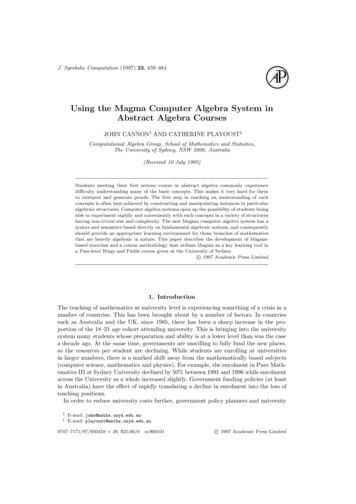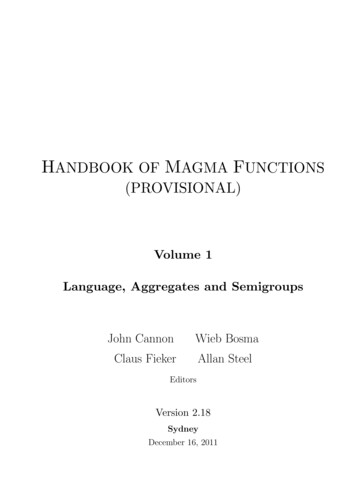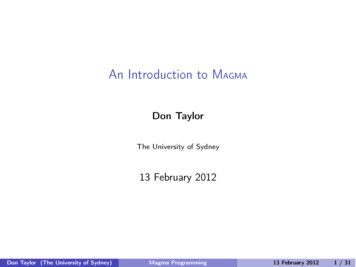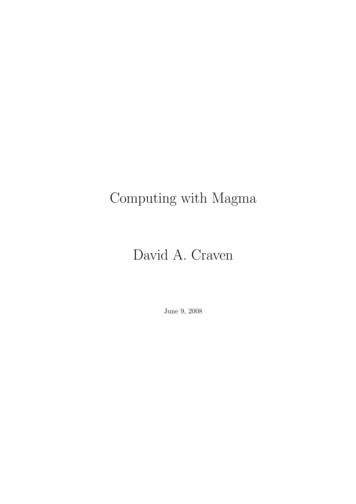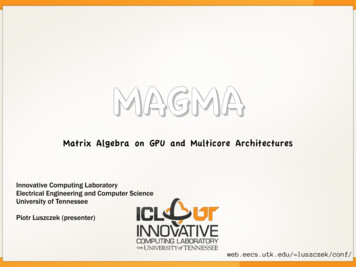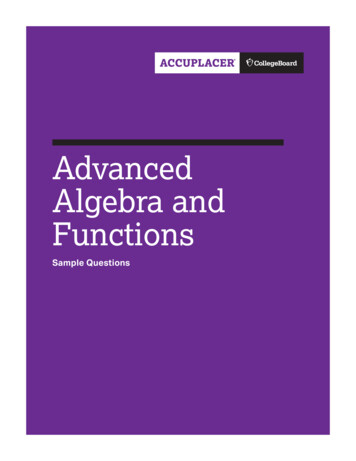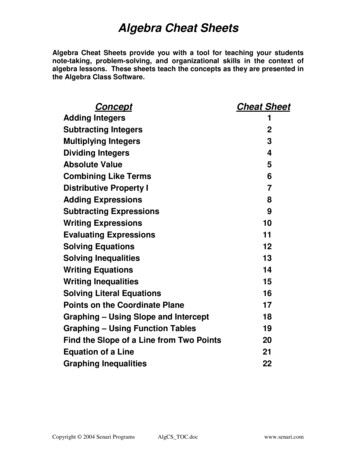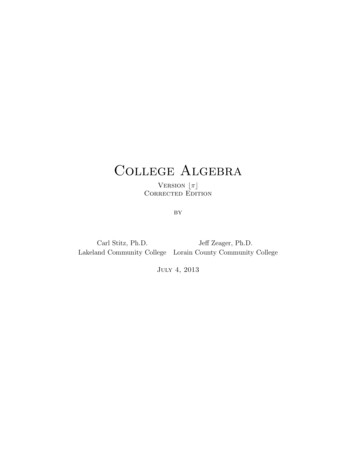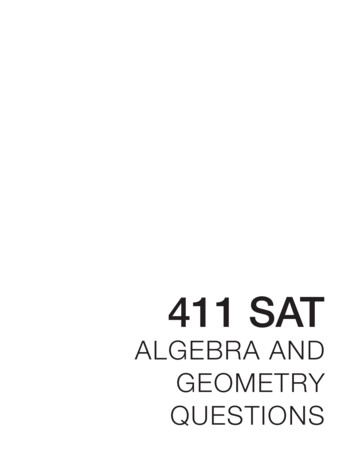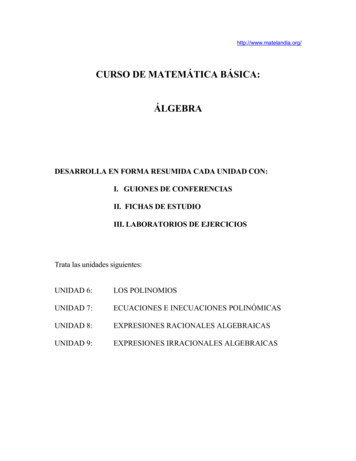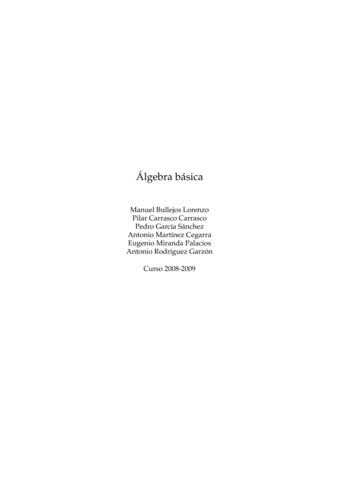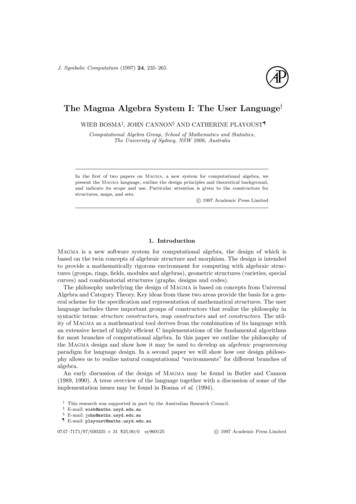
Transcription
J. Symbolic Computation (1997) 24, 235–265The Magma Algebra System I: The User Language†WIEB BOSMA‡, JOHN CANNON§ AND CATHERINE PLAYOUST¶Computational Algebra Group, School of Mathematics and Statistics,The University of Sydney, NSW 2006, AustraliaIn the first of two papers on Magma, a new system for computational algebra, wepresent the Magma language, outline the design principles and theoretical background,and indicate its scope and use. Particular attention is given to the constructors forstructures, maps, and sets.c 1997 Academic Press Limited1. IntroductionMagma is a new software system for computational algebra, the design of which isbased on the twin concepts of algebraic structure and morphism. The design is intendedto provide a mathematically rigorous environment for computing with algebraic structures (groups, rings, fields, modules and algebras), geometric structures (varieties, specialcurves) and combinatorial structures (graphs, designs and codes).The philosophy underlying the design of Magma is based on concepts from UniversalAlgebra and Category Theory. Key ideas from these two areas provide the basis for a general scheme for the specification and representation of mathematical structures. The userlanguage includes three important groups of constructors that realize the philosophy insyntactic terms: structure constructors, map constructors and set constructors. The utility of Magma as a mathematical tool derives from the combination of its language withan extensive kernel of highly efficient C implementations of the fundamental algorithmsfor most branches of computational algebra. In this paper we outline the philosophy ofthe Magma design and show how it may be used to develop an algebraic programmingparadigm for language design. In a second paper we will show how our design philosophy allows us to realize natural computational “environments” for different branches ofalgebra.An early discussion of the design of Magma may be found in Butler and Cannon(1989, 1990). A terse overview of the language together with a discussion of some of theimplementation issues may be found in Bosma et al. (1994).†‡§¶This research was supported in part by the Australian Research Council.E-mail: wieb@maths.usyd.edu.auE-mail: john@maths.usyd.edu.auE-mail: playoust@maths.usyd.edu.au0747–7171/97/030235 31 25.00/0sy960125c 1997 Academic Press Limited
236W. Bosma et al.2. The Magma Philosophy: Design CriteriaThe process of designing a computer algebra system involves choosing a mathematicalviewpoint and then selecting one or more programming language paradigms (procedural,functional, rewrite rule-based etc). A given system will be based on a particular viewpointchosen from among the many different ways of looking at an area of mathematics. Notonly are different approaches evident in different branches, but even within a singlebranch, quite different viewpoints often co-exist.Modern algebra is characterized by the process of abstracting minimal sets of axiomssatisfied by some particular class of structures and then attempting to produce a classification of the entire class of structures satisfying that axiomatic system. The internalstructure of an algebraic structure plays a central role in classification efforts. Importanttools are structure-preserving mappings (morphisms) and actions of structures.The design of Magma is firmly rooted in this structural view of algebra. The fundamental notions underlying the system design are those of algebraic structure and morphism.Having chosen a mathematical viewpoint, it is now appropriate to state a number ofmore specific criteria: The language should be “universal-algebraic” in the sense that its design philosophyshould strive to be equally appropriate for all branches of algebra and related fields. Algebraic structures and their morphisms are to be first class objects. The language should ensure that the specification of mathematical objects andtheir attributes is precise and unambiguous. The semantics associated with eachobject definable in the language should be as close as possible to the standardmathematical interpretation. The user language should support common mathematical notation as far as possible. “Mathematical” data structures, such as sets, sequences and mappings, are usedrather than the more standard computer science data structures such as arrays,lists and trees. Efficiency is a paramount concern.In the following paragraphs we expand on some of these points.Universality. A system design that provides a satisfactory computational environmentfor all areas of mathematics has not yet appeared, and for good reason: it is probablyimpossible. For example, an environment supporting computation in analysis, where theproblem of expression simplification is central, will differ very significantly from an environment for constructive combinatorics where backtrack search is the main tool. Onthe other hand the many excellent systems developed for particular branches of mathematics (KANT, LiE, PARI, Macaulay, Snappea etc) suffer from the disadvantage thatmany practical computations will involve the use of tools from neighbouring areas. Wehave chosen to design a system for an area of mathematics that is, hopefully, sufficientlybroad to encompass a large class of mathematical computations that rely heavily onalgebraic calculation, but which is sufficiently constrained that the adoption of a singlemathematical viewpoint will work equally well throughout the area.First class status for structures. Since, operationally, algebraic structures and individual“elements” of a structure are each mathematical entities possessing properties which weseek to investigate, structures need to have first class status in an algebraic language.Thus, it should be as easy to define a polynomial ring R and perform operations on R
The Magma Algebra System I: The User Language237as it would be to define and perform arithmetic with a polynomial. This is in sharpcontrast to the approach taken in systems such as MACSYMA, REDUCE, Maple andMathematica which have adopted an “element-centred” model of algebra and providevirtually no support for structural computation.Precision and the avoidance of ambiguity. The central notion here is that of “context”:the answer to mathematical questions (and indeed, their appropriateness) often dependsupon the context in which they are asked. As a simple example, consider the problemof factoring x3 1. At first sight this is an innocuous and appropriate question for asymbolic algebra package. Upon reflection, however, it is entirely unreasonable to expecta solution from any system without further context: if, “in the current context” x isan identifier with the integer 4 assigned to it, then evaluation should yield the answerx3 1 32 · 7. A computer algebra system would be able to decide that no “value”has been assigned to x yet, but ambiguities arise if it assumes next that x refers toa transcendental element: it will then have to decide over which structure to factor thepolynomial x3 1. One possible solution, often adopted by conventional symbolic algebrasystems in some form, is to make the notion of context explicit: the user specifies a contextin which computation is to be performed, so that a change of context changes the domainof computation. Serious drawbacks to this approach include the difficulty of computingsimultaneously in various structures, and the counterintuitive change of “meaning” ofobjects whenever the exterior context is changed. While such an approach may workfor elementary applications in which computation takes place in a single fixed structure,in more sophisticated algebraic computation, where objects of one structure interactwith those of another, it becomes difficult if not impossible. The solution chosen forMagma is to associate with every object its unique context, in the form of the “parentstructure” to which it belongs. It is impossible to define x3 1 in Magma without(explicitly) designating the structure to which it belongs. If, for example, it is defined tobe an element of the polynomial ring Z[x], factorization results in its factorization intoa product of irreducible polynomials over Z.Efficiency. Since Magma is intended as a heavy-duty research tool, its fundamentalalgorithms need to be as fast as possible. The difficulties of achieving satisfactory speedof execution will be clear to anyone who has undertaken the development of mathematicalsoftware. Since the optimal choice of data structures is crucial for many algorithms, theimplementation of such algorithms in a high-level general algebraic language suffers thedrawback that the use of generic data structures rather than the optimal data structuresfor a given problem will often result in the loss of a considerable degree of efficiency. Thisis true regardless of whether the language is interpreted or compiled into some low-levellanguage such as C or Lisp. One approach to this problem is to install fundamental orparticularly time-critical algorithms in the C kernel. To avoid the cost of re-implementingevery relevant algebraic algorithm, the Magma internal system architecture makes itpossible for certain classes of specialist software written independently of Magma to beinstalled in the kernel at the cost of a modest amount of effort.3. Theoretical FoundationsIn order to produce a coherent design, we require a model of algebraic computationthat specifies the possible classes of objects that may be defined within the scheme, andallows the valid operators for a given class of objects to be recognized.
238W. Bosma et al.An essential prerequisite for mathematical rigour is a strongly typed system. Ideas fromUniversal Algebra and Category Theory have been used to develop a theory of formalalgebraic specification of data structures and their operations (Burstall and Gougen, 1981;Gougen, 1989). This work underpins semantic models for Computer Algebra systemssuch as AXIOM (Jenks and Sutor, 1992) that support strong typing. Recently, Hearn andSchrüfer have used the theory of order-sorted algebras to develop a proposal for a stronglytyped language for the Computer Algebra system REDUCE (Hearn and Schrüfer, 1995).This body of work is chiefly concerned with defining a satisfactory system of types in aparticular context and explicating the relationships between the different types.While no description known to us of the semantics of algebraic computation seems to becompletely satisfactory, we have found that ideas from Universal Algebra and CategoryTheory provide a useful framework. Although the description of our model takes itsinspiration from these sources, the Magma notions of algebra, category and variety donot strictly adhere to the standard definitions. We use these concepts not only to developa theory of algebraic types and their representation, but also to identify operations thatare common to large classes of algebraic and geometric structures.In the next sections we briefly outline the basic ideas of multi-sorted algebras andcategories in order to provide the reader with an understanding of the foundations ofthe Magma model. Our overview of universal algebra follows that of Meinke and Tucker(1992), and the reader is referred to this excellent exposition for a detailed account. Forthe notions of category theory we refer the reader to Mac Lane (1971).3.1. multi-sorted algebrasTo define multi-sorted algebras, we fix a non-empty set S of sorts. Although manyfamiliar algebraic structures may be described as single-sorted algebras, it will be convenient to consider multi-sorted algebras.A multi-sorted algebra A consists of a family {As : s S} of non-empty sets As calledcarrier sets, together with a signature Σ; the signature identifies certain distinguishedelements of the carrier sets as well as the collection of allowable operations in A, and isformalized as follows. By S we denote the (possibly empty) set of words in the elementsof S; by λ we will denote the empty word. A signature Σ is an S S indexed collection of Asets {ΣAw,s , w S , s S}. For each sort S, the set Σλ,s As consists of the constants ofsort s in A, while for each non-empty word w s1 · · · sk and sort s the set ΣAw,s consistsof the operations σ: As1 · · · Ask As , of arity k, with domain As1 · · · Ask andco-domain As .We should therefore speak of “multi-sorted Σ-algebras”, but in the remainder of thissection the abbreviated term “algebras” will be used.There are three standard constructions which, when applied to algebras, produce newalgebras. These are the subalgebra, quotient algebra and direct product constructions. Webriefly sketch their definitions. Let A and B be S-sorted algebras. Then a subalgebra Bof A is defined as follows:(i) The carrier sets of B are subsets of the carrier sets of A: i.e., Bs As , for s S.B(ii) The constants of B are identical with those of A: i.e., ΣAλ,s Σλ,s , for s S.(iii) The operations on B are obtained by restricting the operations on A to B: i.e.,σB (b1 , . . . , bn ) σA (b1 , . . . , bn ), for σ Σw,s , bi Bsi .
The Magma Algebra System I: The User Language239If B is a subalgebra of A then we write B A. The notion of a subalgebra leads to aconcept that is fundamental for computation: generating set. Let A be an algebra andlet X A. Then\BhXiA X BB Ais the subalgebra generated by X A. It is not hard to show that this intersection definesa subalgebra provided the intersection of carrier sets is non-empty. The statement that Ais generated by X A is equivalent to hXiA A. Further, we say that A is finitelygenerated if and only if hXiA A, for some finite set X. The idea of a generating setprovides us with an extremely compact method of representing algebras: rather thanexplicitly listing the elements of carrier sets, we will describe them in terms of (usually)small sets of generators.A (Σ-)congruence is an S-sorted family of equivalence rela
Computational Algebra Group, School of Mathematics and Statistics, The University of Sydney, NSW 2006, Australia In the rst of two papers on Magma, a new system for computational algebra, we present the Magma language, outline the design principles and theoretical background, and indicate its scope and use. Particular attention is given to the constructors for
